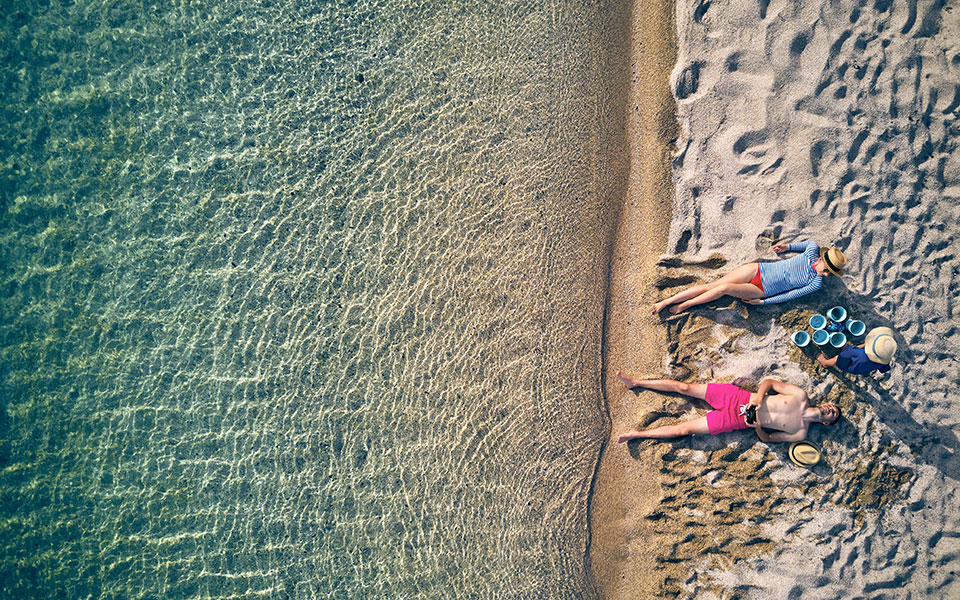Whether your family delights in beach fun, long hikes in stunning natural surroundings, cultural exploration through picturesque villages and impressive archaeological sites, or simply relaxing in nature and enjoying beautiful views, this guide offers you plenty of ideas to keep you busy and enjoy your vacation to the max.
These highly recommended destinations are not listed in order of preference – each and every one is a wonderful destination in itself!
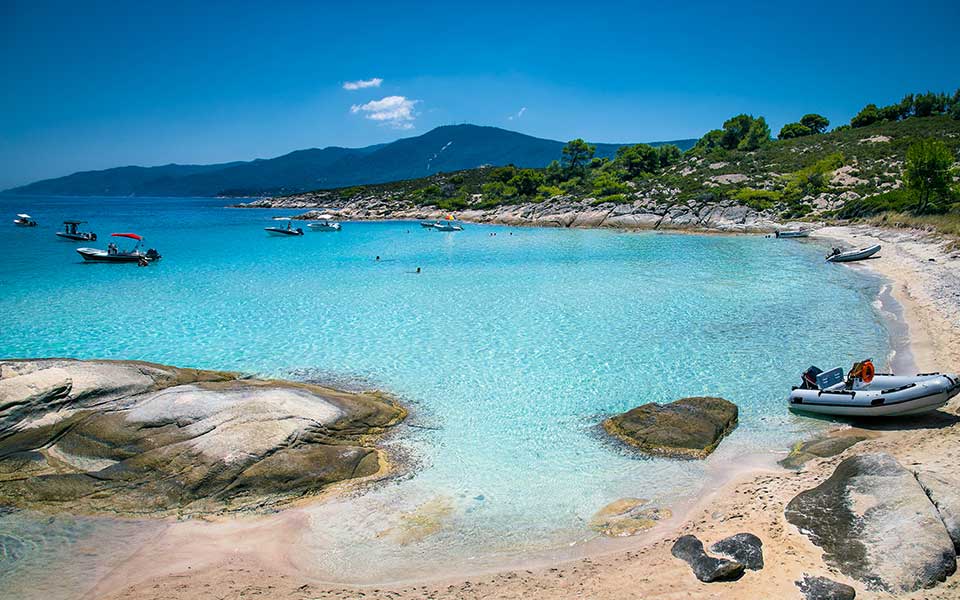
© Shutterstock
Halkidiki
The so-called “Riviera of the North” remains the most popular holiday destination in the region mainly because of its seemingly never-ending stock of natural attractions. Halkidiki is a region blessed with places of rare natural beauty as stunning as they are diverse. In an enchanting blue-green setting dominated by forests of pine trees and beautiful stretches of seashore, visitors can discover locations ranging from exotic islets and endless sandy beaches washed by crystal-clear waters to dense forests with oak trees and waterfalls.
What to See & Do
Kassandra is chiefly known for its cosmopolitan feel, with Sani Marina and beach bars stealing the show, but is also very popular among nature-lovers on account of its many secluded beaches and camping options. Visit the natural springs of Aghia Paraskevi, said to have therapeutic properties. In Stagira, the birthplace of Aristotle, just 73km from Thessaloniki, you’ll find interactive exhibits in a fascinating park dedicated to propagating the great philosopher’s teachings.
The ancient city of Olynthus, built in a fertile valley near the buzzing town Moudania, offers a rare insight into life in Neolithic times at its excellent museum. Meanwhile Petralona Cave, formed around a million years ago in the limestone of Katsika Hill and nicknamed “the red-rock cave” will wow all the family. Today it’s the most important of Greece’s 12,000 caves, thanks to its wealth of fossils (one of the richest collections in Europe) and to the discovery, around half a century ago, of the oldest human remains ever found in Greece.
The area north of Mount Athos in the easternmost part of Halkidiki, a region which includes the island of Ammouliani, is constantly upgrading its services to offer visitors unique experiences, such as the Aristotle Trail and mountain trekking on Mount Holomon.
Where to Swim
Halkidiki arguably has the best beaches on the Greek mainland and the most Blue Flag-awarded beaches in Greece (87 in 2021). Stunning sandy stretches and coves can be found along its crenelated coastline, facing crystal waters in hues of blue and green. The effect is a painter’s palette, created by the union of lush vegetation with the sea. Some fabulous swimming spots are Toroni beach, an untouched hidden paradise with a primordial atmosphere, Sani beach, Karydi, Tigania, and the small islet of Diaporos, known locally as Hawaii, as well as magnificent Kavourotripes, meaning “crab holes,” is for those who prefer not to get into the car with sandy feet.
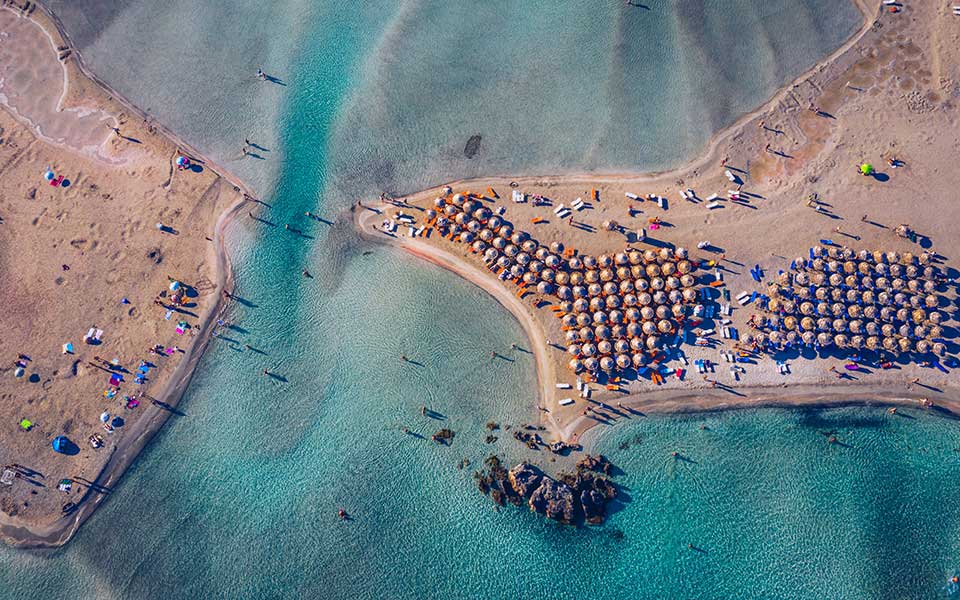
© Shutterstock
Hania, Crete
Hania is by far the prettiest and most captivating of Crete’s cities. Many even believe it to be one of the most beautiful in the Mediterranean, calling it the “Venice of the East.” This, together with lovely beaches, hiking trails and plenty of great places to see makes it a great family destination.
What to See & Do
Tourists usually head straight for the picturesque Venetian harbor and, despite the crowds, so should you, but only as a start, and only so you can walk to the Egyptian lighthouse, which enjoys a panoramic view of the harbor. Coming back to the Old Town, check out the Municipal Market (69 Agoras Square) where locals do their daily shopping and where you can find Cretan souvenirs, both edible and non-edible, to take home.
Make your way to Kastelli Hill, where the center of the ancient city of Kydonia (on which modern-day Hania was built) was located. The area has some wonderful surprises, like the Venetian Rector’s Palazzo (17th century) at the end of Lithinon Street and a marvelous, panoramic view of the harbor from the “Balcony of Hania” at the end of Aghiou Markou Street. For ancient culture, visit the new Archaeological Museum of Hania, which tracks the continuity in western Crete from prehistoric through to historic times.
Hania is also famous for its beautiful hiking routes. It may be mostly known for the Samaria Gorge, but it’s home to a wide variety of trails that are connected to different parts of its history, from the Minoan Bronze Age to the Pre-Industrial period. In collaboration with local municipalities and the Social Co-operative Enterprise, Paths of Greece, an initiative spearheaded by the regional unit of Crete includes a network of at least 60 trails, totaling a length of 600 kilometers.
In the evenings drop by the port which, with its illuminated lighthouse, which looks like the setting for a huge party. Join the hundreds of tourists and locals strolling on the esplanade or opt for one of the many cultural events taking place either near or inside famous landmarks: Greek folk dance performances around the back of Yali Tzamisi (the oldest surviving mosque in town), exhibitions inside the Grand Arsenal (the largest of the 15th-century neoria, or dockyards, of the port), concerts at Firkas Fortress, and more.
Where to Swim
The beaches of Hania are among the most famous worldwide. Some of these are Balos, which has shallow waters, Gramvousa, the superb sandy beach of the uninhabited islet of Gramvousa, reachable by caique, Elafonisi at the southwestern tip of Crete, which is a a Natura 2000 protected area; Falasarna, with light blue and crystalline waters and pink sand from thousands of seashells. In the southwest, visit Kedrodasos beach, washed by crystal-clear water, Aghia Roumeli, which lies at the end of the Samaria Gorge (a reward for those who complete a 5-hour trek).
From Hora Sfakion, you can hop on one of the boats departing for Aghios Pavlos, a beach with pine trees, a taverna and a charming 11th-century chapel, or for Marmara beach with its amazing sea caves. Gialiskari‘s sandy stretch and Krios, a beach of fine shingle, are among the most impressive beaches near the village of Paleochora, and Tripiti, Domata, Likos, Finikas, Glyka Nera and Iligas are all secluded beaches in the area of Sfakia worth exploring.
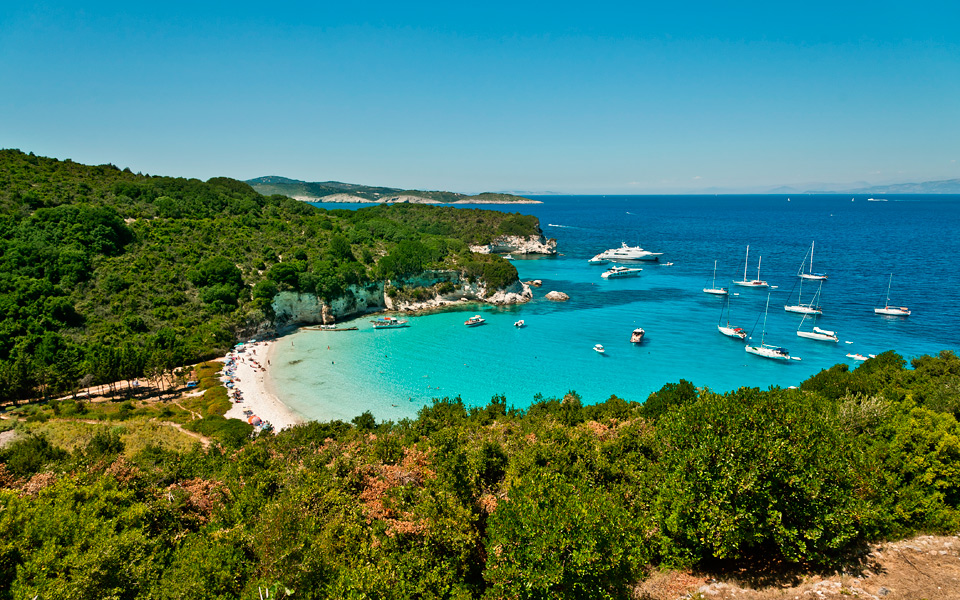
© Shutterstock
Paxos
Although it neighbors Corfu and faces mainland Parga – both extremely popular tourist destinations, Paxos has preserved its pristine allure. Its all about the diaphanous azure-emerald sea on Paxos, so if you and your kids are the kind of people who practically have gills, this is the place for you. A classic way to holiday here is to rent a small boat and spend days swanning around, stopping off anywhere and everywhere to plunge into the cool depths, getting your land-legs back just long enough for a spot of lunch before returning to aquatic adventuring. That’s not to say that there aren’t plenty of child-friendly beaches to kick back on, with sun loungers and umbrellas for rent.
What to See & Do
Paxos has just three villages that are all very well suited for families. Each of the villages has their evening charms. The pastel pink port of Gaios with its Venetian architecture is the busiest and the place to shop for supplies. Lakka and Loggos are especially picturesque with motor yachts, sailboats and fishing boats moored in their harbors. Both have an elegant allure (which is why they have attracted A-list film stars and British royalty alike) yet maintain a relaxed ambiance.
Kids from around the world play and a cacophony of different languages is carried along by the sea breeze as parents sip their wine. Cobblestoned paths, Spanish Steps, age-old cisterns, the orange, twin-domed Ypapantis church and tall bell tower, which stands alongside it like a gentleman, make up some of the island’s charming features.
Where to Swim
Most of the island’s more popular beaches, such as the partially organized Levrechio, Loggos, Harami and Monodendri are reachable by foot. However you’ll need a trail map such as the one produced by longtime Paxos regular Ian Bleasdale.
For even more ease and fun, hire a boat from Loggos, load it up with food, water, hats, armbands, masks and snorkels and spend the day captaining as you explore Paxos’s sparkling coves and beaches. All are pebbled except for man-made Mongonisi, on the southern side which is a family favorite.
Neighboring Antipaxos, a pint-sized islet measuring just three square kilometers and located a 13 minute speedboat ride away from Gaios, is surrounded by blue waters. It features vineyards producing a heavy wine, two superb beaches that draw boats from Paxos – Voutoumi, a pebble-covered beach, and Vrika, a sandy beach – as well as a few stray, extremely noisy ducks.
On the eastern coast, the bays of Kypiadi, Marmari and Pounda are more remote and better reached by boat, while on the western side you can explore blue caves, and spot the Ortholithos, which looks like a pyramid rising out of the sea.
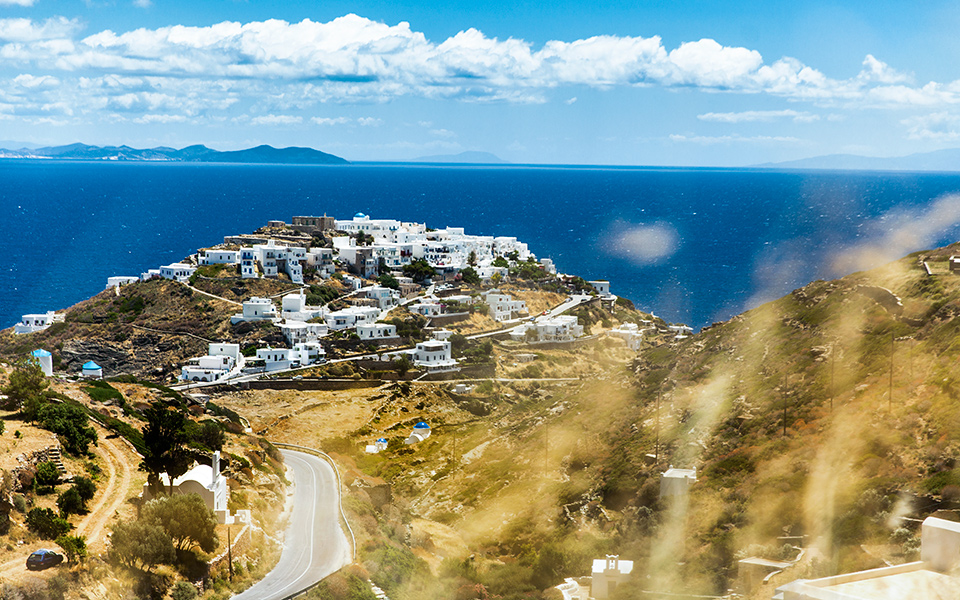
© Dimitris Vlaikos
Sifnos
There’s something very special about Sifnos, probably owing to its effortless beauty and natural elegance. Think mesmerizing island landscapes dotted with dazzling white sugar-cube houses. It’s an ideal destination for families seeking rewarding calm in the heart of the Aegean, away from the cruise-ship crowds of Mykonos or Santorini. With pretty whitewashed villages, delectable traditional foods and plenty of unspoiled sandy beaches with clean, shallow waters safe for kids, Sifnos is an ideal getaway for families seeking laid-back, tranquil holidays in a postcard-perfect setting. Look forward to lazy days watching your kids play on sheltered, shallow-water beaches followed by leisurely walks along quaint, labyrinthine village backstreets or remote pathways overlooking the sea (there are over 100km of well-marked trails).
What to See & Do
Chic and cosmopolitan, but at the same time decidedly familial and low-key, it’s an island perfect for long days at the beach with seafront lunch breaks in your swimsuit. Apollonia, the island’s capital, is Sifnos’ busiest village, and great for shopping, people-watching and finding more international cuisine if your kids are missing pizza or burgers. Being Sifnos’s top nightlife destination, you can also stop here for a sly cocktail at one of the many bars lining the main street.
Artemonas is by far the prettiest village, with a wonderful assortment of tavernas such as Mosaico for meze dishes and Chrysso for lamb chops. But the stop your kids will probably most love you for is Theodorou sweet shop, famous for its homemade almond sweets and nougat wafers. Every September the village also hosts the island’s culinary celebration of Nikolaos Tselementes, (the chef who changed the course of Greek cuisine in the 60s and who is a native of Sifnos’s Exambela village).
Kastro, with high walls, narrow passageways, labyrinthine streets and sweeping sea views, is known for its singular (many say ‘mysterious’) ambiance. Visit the Archaeological Museum and eat at one of the taverns serving fish just plucked from the sea.
Where to Swim
Kamares, the wide, sheltered sandy cove by Sifnos port, is the island’s most popular family spot, with clean and shallow waters and sun loungers and umbrellas to be found at various points. Several cafes and tavernas line the shore, allowing parents to sip iced coffees while watching their kids play right next to them on the sand. There are plenty of hotels, rooms and stores here too, catering to every taste and need, and buses departing to most parts of the island. Aghia Marina, on the far side of Kamares is another popular spot for families seeking more quiet.
At Apokofto beach you can relax on the fine sand under the shade of trees growing only a few meters from the water’s edge, with a view of the lovely monastery of Panagia Chryssopigi in the distance. Another popular family swimming spot is Vathy, a 1.5km shoreline with crystal-clear shallow waters and a variety of pretty seafront tavernas.
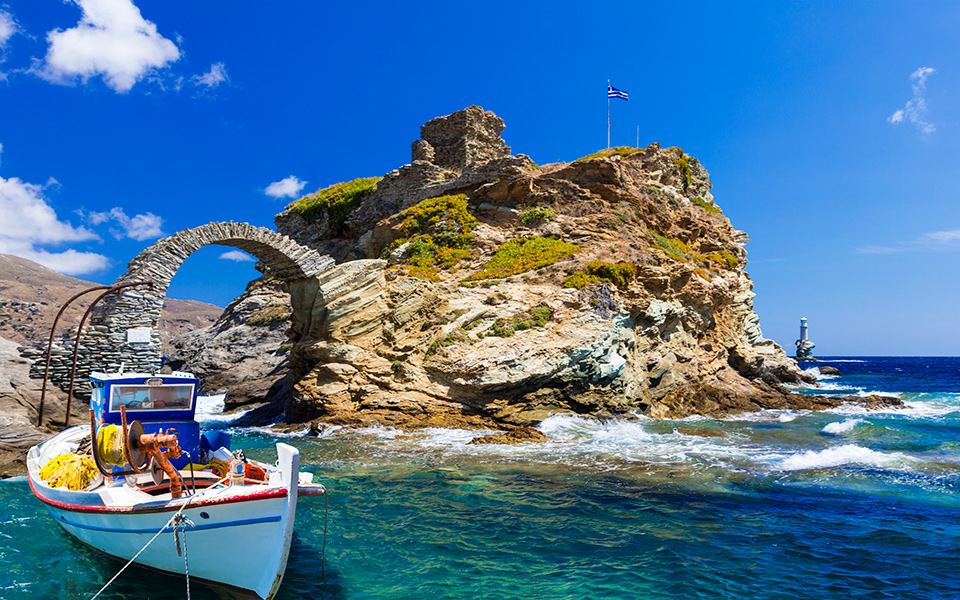
© Shutterstock
Andros
Only two hours ferry ride from the port of Rafina near Athens, Andros’s lush and varied nature (unusual for the Cyclades), quiet villages, unhurried pace of life, scenic beaches and broad variety of inland walking routes make it an ideal family holiday spot. Increasingly trendy over the years, the island is perhaps in its final years of remaining unspoilt, so if you’re seeking tourist-free holidays, get there this year and especially after the peak season.
What to See & Do
The chora, with its elegant cluster of neoclassical mansions built by old ship-owning families, is a great place to hang out in Kairis Square as your kids run free in the pedestrian-only square. The square has two flights of wide stone steps leading to the town’s two beaches, Paraporti and Niborio beach, another long stretch of sand, this one with shallow waters ideal for young kids and lined with tavernas and cafes. On the way you will pass the Goulandris Museum of Contemporary Art, well worth stopping at between June and September to see the annual art exhibition.
Visit the statue of the Unknown Sailor and right across, see the ruins of an old Venetian castle and further on, the iconic Tourlitis lighthouse.
A trip to the amphitheatrically developed Stenies, a village featuring superbly preserved mansions owned by prominent shipping families, comes highly recommended. For a more international feel, head to Batsi and take a stroll. Korthi, on the southeastern side of the island, is another popular spot for kids to swim and play as its main bay has shallow, clean and sheltered waters, especially at the beach by Aghia Katerina church.
Andros’s varied landscapes, especially bountiful in spring and early summer, can be enjoyed via long walks along the island’s old paths, known as kalderimia, most of which have been cleared and restored by various local and visiting organizations. Award-winning Andros Routes organizes various hikes for groups of all ages and abilities, as does Trekking Andros; the latter also organizes a variety of other family-friendly activities such as cooking classes and more.
Where to Swim
Although the Chora’s Niborio and Paraporti beaches are popular and charming, there are some far better shores to visit with your kids on the island. Given the prevailing north – north-easterly winds in the summer, most of the more sheltered beaches are located on the western coast.
Starting from Gavrio port, head to Chryssi Ammos (Golden Beach) or Aghios Petros (near touristy Batsi village), a large sand beach with shallow waters that also has loungers and umbrellas for rent and nearby cafes for refreshments and snacks. Likewise on blustery days Chalkolimionas is a good choice as it’s protected from the winds. For older children interested in windsurfing lessons visit Kipri beach.
Also child-friendly is Gialia on the eastern side, at the back of which, under the shady bridge, is a giant pond where kids can see dragon flies, frogs, ducks and swans. More scenic but not shallow beaches are white sand-turquoise water Achla, north from Chora where there is also a river which sometimes plays host to swans and their cygnets.
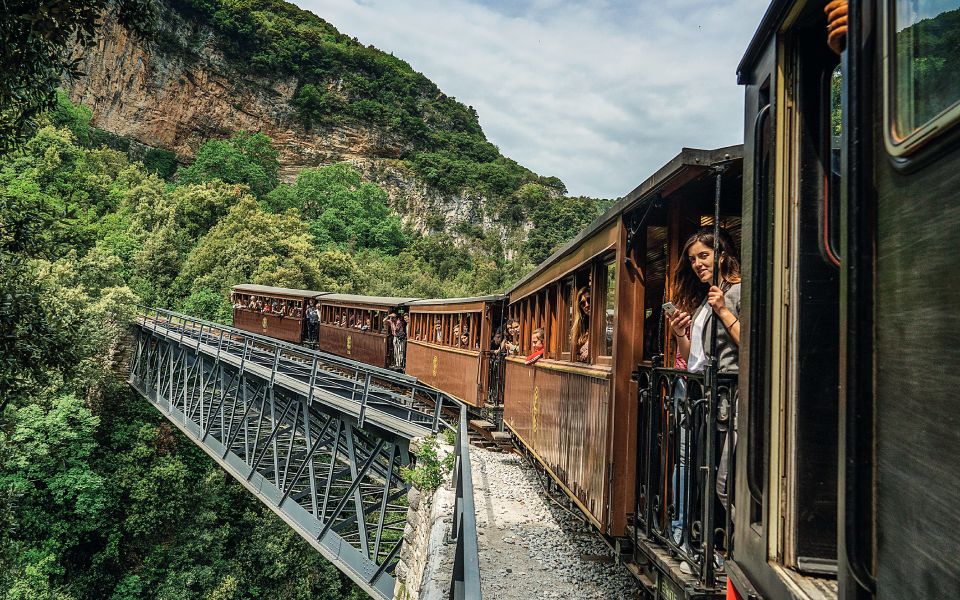
© Perikles Merakos
Pilio
In Mount Pilio you and your family can have the best of both worlds: easy access to some of the country’s most splendid beaches as well as some of its greenest, most idyllic mountain villages. It’s not by chance that this was the holiday spot of the 12 Greek Gods and legendary land of the centaurs: in Pilio you can fully savor old fashioned tranquility. Here your days will revolve around swimming at sandy, child-friendly beaches, before snaking up oak, fir and plane tree-lined roads (especially on the northern side) that are like cool jungly tunnels speckled with shards of light.
What to See & Do
The slopes of Pilio are famed for their biodiversity, as the mountain’s proximity to the sea creates a large variety of microclimates in a relatively small area. Here the forests are full of medicinal herbs (many of which are dried and sold in the villages), wild blackberries to pop into your mouth, toads, electric blue dragonflies, hedgehogs, deer and foxes. In the villages, ancient walls are splashed with bougainvillea, the air is laden with the mulchy, musty aroma of wet vegetation and kids can run free, playing hide-and-seek in village squares. It’s well worth renting a car for your Pilio holiday so that you can make the best of its varied landscapes, villages and beaches.
Must-see villages to take your kids are Aghia Kyriaki, a fishing village on the southern side, where you can swim and have a delicious seafood meal or lobster pasta, crispy whitebait and other fresh delights at tavernas To Mouragio or O Manolas. A wonderful way to see Pilio that is bound to delight children is via the ‘Moutzouris’ steam train that sets off from Ano Lechonia and heads to Milies in a 90 minute ride, stopping at various villages. Beautiful Tsagarada is also an ideal destination for kids, where they can run along cobblestone paths and climb the giant ancient plane tree in Aghia Paraskevi Square. Other scenic villages are Milies and Mouresi, one of Pelion’s oldest.
Where to Swim
On the southern side of Pilio, along the Pegasitic Gulf, child-friendly beaches include Belian, Marathias, Paou and Katigiorgis, the last being a small, clean beach next to a tiny fishing village. On the northern side, Aghios Ioannis is one of the most popular swimming spots by far, as is Papa Nero right next to it. At Mylopotamos to the northeast, the water is deeper and getting to the sea requires a short walk down from the road, but the water is magnificent. One the southeast, head for the large stretch of sand at Horefto (nudists usually bathe at the far end) and Mourtia.

© Shutterstock
Alonissos
It is widely known as “the green island” for having developed an ecological profile that goes beyond its abundant vegetation. The island is located in Greece’s largest and most impressive marine park, and more recently an underwater museum. It is perhaps no surprise that Alonissos is also a hiker’s paradise, and there are several guidebooks directing you to the perfect paths for every level.
It’s the kind of island where children can connect with nature, and that’s not all. There is no shortage of pretty, child-friendly beaches, authentic home-style and seafood tavernas and cafes serving full breakfasts and desserts with arresting vistas. Often visited by families on day trips from nearby Pilio, Skiathos or Skopelos, Alonissos is actually a great base in its own right for families seeking a holiday haven where they can fall into the tranquil local pace of life.
What to See & Do
The other most favorable and more scenic destination for families is The Old Town. Here you can rent traditional houses to stay in as well as rooms in hotels and bed and breakfasts. The town’s Venetian-inspired architecture painted in russet, white and gold shades, steep stairways and tranquil stone pathways are surrounded by buzzing nature – you are likely to see hawks circling high overhead and butterflies pollinating passion flowers.
The island is located in Greece’s largest marine park. As a result its waters are some of the richest in Greece in terms of sea life. At the Underwater Museum, amateur divers can explore the wreck of a ship that went down off the protected islet of Peristera in the 5th century BC carrying a cargo of hundreds of amphoras of wine. Dives are conducted under the guidance of experienced divers.
With 14 marked hiking routes of varying difficulty, it’s an ideal destination for family hikes. Boats and kayaks can be rented so you can spend days exploring the magnificently clear waters around Alonissos and the neighboring uninhabited island of Peristera. If you’re lucky you may even be accompanied by the dolphins that frequent the area.
Where to Swim
Alonissos is not particularly famed for its sandy beaches, as rock and pebbles are its dominating coastal features. However, there is no shortage of beautiful, child-friendly shores encroached by pine trees that provide shade and a summery chorus of buzzing cicadas. Among the few organized and sandy beaches with several nearby tavernas is Chryssi Milia, (5km from Patitiri port) which is the most popular among families because of its shallow waters. Tzortzi Gialo (7km from Patitiri) is a shallow water pebble beach and has a taverna nearby.
The pebbles on another child-friendly beach, Leftos Gialos (midway between Patitiri and Steni Vala) gleam white and contrast idyllically with the turquoise sea, which is probably why this organized beach is among the most popular on the island. Closest to Patiri is Megalos Mourtias, a pretty, but quite busy beach that’s sheltered and has several tavernas nearby, such as Megalos Mourtias which serves traditional home-style dishes. If your kids love snorkeling, Tsoukalia is a unique spot for it. Although not the most remarkable at first glance, the beach is actually an archaeological site where ceramic wine pots (tsoukalia) were once produced in ancient times and again during the 20th century.
If you have older kids and want to combine your beach-going with a hike, visit Votsi, which is embraced by pines and has crystalline emerald waters.
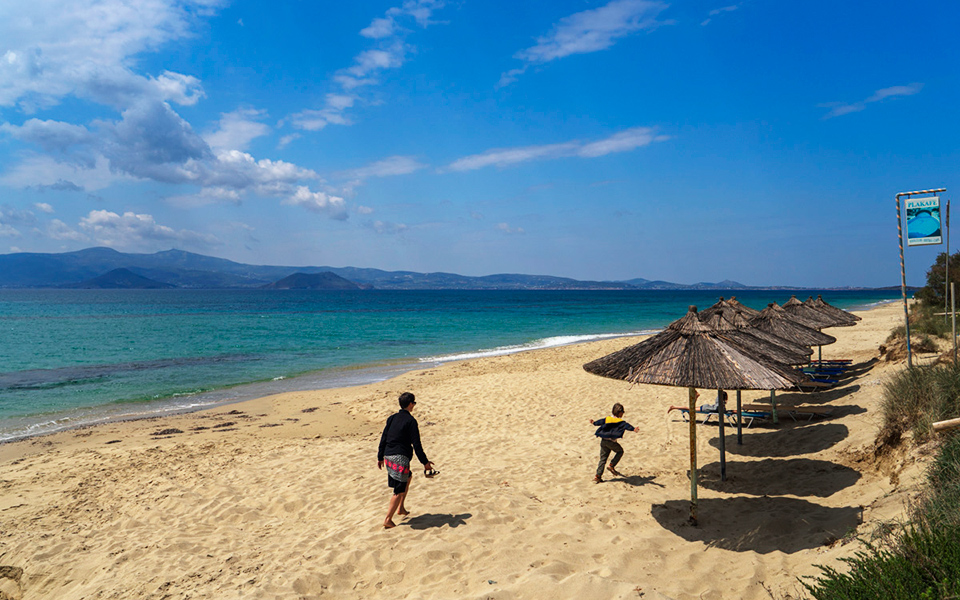
© Perikles Merakos
Naxos
Fine architecture, great beaches and quaint villages are some of the reasons why it has become a much-loved destination, particularly for many families. Naxos is the largest of the Cycladic islands, self-sufficient and autonomous, and that is the sense you get everywhere here.
Rich in everything, Naxos is ideal for every type of visitor. This is why you will find here families, alongside teenagers on their first forays without their parents, active types and cosmopolitan types. Here we explore Naxos through the sports activities it offers visitors, and yet again gives us a time to remember.
What to See & Do
Naxos also has a constellation of picturesque, mountainous villages that can be a refreshing alternative to the beach – perfect for those who want an early morning or late afternoon stroll. Apeiranthos, also known as “the marble village” is home to the 17th century Venetian Zevgoli tower built atop a massive rock, as well not one but four museums, specifically the Archaeological Museum, Visual Arts Museum, Geological Museum and Museum of Natural History.
You can enjoy the sea views from the nearby fishing village of Moutsouna, once Apeiranthos’s harbor where local marble was once loaded onto ships for transport. The Jesuit Monastery is also a sight worth discovering, located 2kms away from the village Melanes, accessible via a passable dirt track in an area known as Kalamitsia. This monastery, also known as the Jesuit Palace, is surrounded by low hills and olive trees.
Naxos is also popular for windsurfing, kitesurfing, kayaking, hiking and horseback riding. Find out more here.
Where to Swim
Plaka beach on the southwestern coast is a favorite destination for families seeking carefree seaside recreation. There is a long, wide sandy strip where you can rent rooms and simply spend the day swimming and relaxing. Visitors are spoilt for choice with a generous selection of accommodation and restaurants serving international cuisine – so there’s something for every appetite. Plaka connects with Aghia Anna, one of the island’s most cosmopolitan beaches. Here you will find calm waters, golden sand complete with sunbeds and umbrellas, an array of eateries and a quaint local church that offers an excellent view of the sunset.
If you’re a water sports enthusiast, head to Maraga for windsurfing and kitesurfing. Aqua Fun Park is also perfect for aquatic adventures beyond the beach. Located just outside the village of Stelida, it is equipped with various waterslides (suitable for both kids and adults), a pool bar, restaurant and features daily events. For those who want to enjoy the beach without actually swimming, visit the Naxos Horse Riding Club which offers scenic rides for all ages and levels of experience.
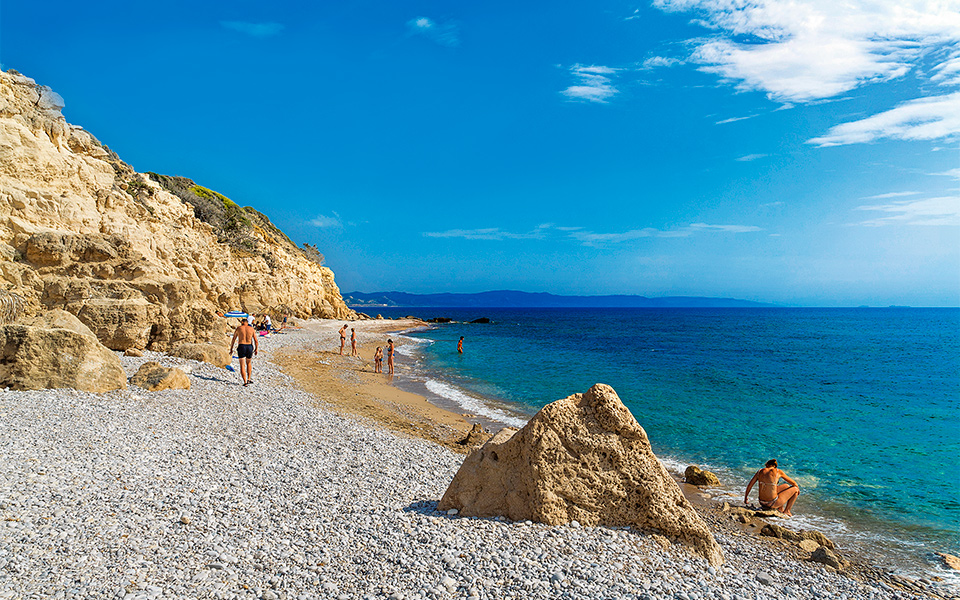
© Perikles Merakos
Rhodes
As a destination, Rhodes offers a wide variety of activities, accommodation options and experiences to be had, and while there are certainly great beaches to choose from for your first swims of the year, you’ll have just as good of a time discovering the medieval Old Town and the nature of the inland.
What to See & Do
The medieval Old Town of Rhodes is no longer the target of pirates or other attackers, although it may appear at times to be under siege by mass tourism. This UNESCO-protected World Heritage Site combines vestiges from a glorious past – Byzantine temples, Crusader-era buildings and Ottoman mosques – with a lively present. Read more on the Old Town here.
The classical city of Rhodes was founded in 408 BC on the site of present-day capital of the island by three towns – Ialyssos, Kamiros and Lindos – all acting together. All three of these ancient towns are now archeological sites which you can visit; Lindos, with its acropolis, is the most famous. Each year, countless eyes gaze in awe at its temple, erected in the 4th century BC in honor of the goddess Athena, and the Crusader-era castle that was subsequently built.
The fortresses of Monolithos and Kritinia on the western part of the island, and those of Feraklos, Archangelos and Asklipeio on its eastern side. The stone-paved alleys in the village of Koskinou, just 7km from Rhodes Town, are pleasant for strolls. The houses here are among the few in Rhodes that retain the old-style architecture. You can see large limestone doorframes (pyliones) leading to flower-filled patios, and even the newer houses are painted in bright colors.
Rhodes is an enchantingly verdant island, with many areas of rich vegetation and natural beauty. One of the most famous of these is the Valley of the Butterflies, named in honor of the Panaxia Quadripunctaria, a member of the Jersey Tiger moth family that looks very much like a butterfly. They gather in great numbers here in the canyon of the Pelekanos River, 25km from Rhodes Town. Just outside Rhodes Town, a mere 3km along the road to Lindos, you’ll reach Rodini Park, one of the oldest landscaped parks in the world, thought to be the site of a school run by the great orator Aeschines. Lose yourself in this green oasis with its flowing water, wooden bridges and ancient plane trees with their enormous, gnarled trunks, and don’t be surprised if you encounter deer, peacocks and ducks.
Where to Swim
If you’d rather avoid the better-known beaches drive south – the further south, the fewer crowds you will encounter. With a 253km of coastline, there’s plenty of variety. Some people prefer rocky coves where they can dive off boulders or outcroppings, while others opt for sandy beaches.
Rhodes Town has a big beach stretching across the entire tip of the peninsula, with the Aquarium at its center. The western part tends to get more wind in the summer, while in the winter, it’s the turn of the eastern part, which reaches all the way to the building known as the Elli, from which this beach takes its name. A favorite with locals and visitors staying in the town, the beach is packed with umbrellas and sunbeds. From Rhodes town to Kolymbia Rhodes’ eastern coast is its busiest and offers everything from sandy stretches to craggy bays and from family tavernas to beach bars. In addition to the famous Water Park, Faliraki Bay boasts a pebbly beach located in front of the big hotels, and a central beach that is family-friendly (with fine sand and shallow waters).
A whole other group of beachgoers cares as much about the wind as the sea, and seeks out places like Prasonisi, whose strong westerly winds make it ideal for kite-surfing and windsurfing. Lindos has three beaches and all are developed and have facilities. These are Megalos Yialos, Mikros Yialos, and St. Paul’s (the last lies beneath the Lindos acropolis and boasts a lovely beachfront bar-restaurant).
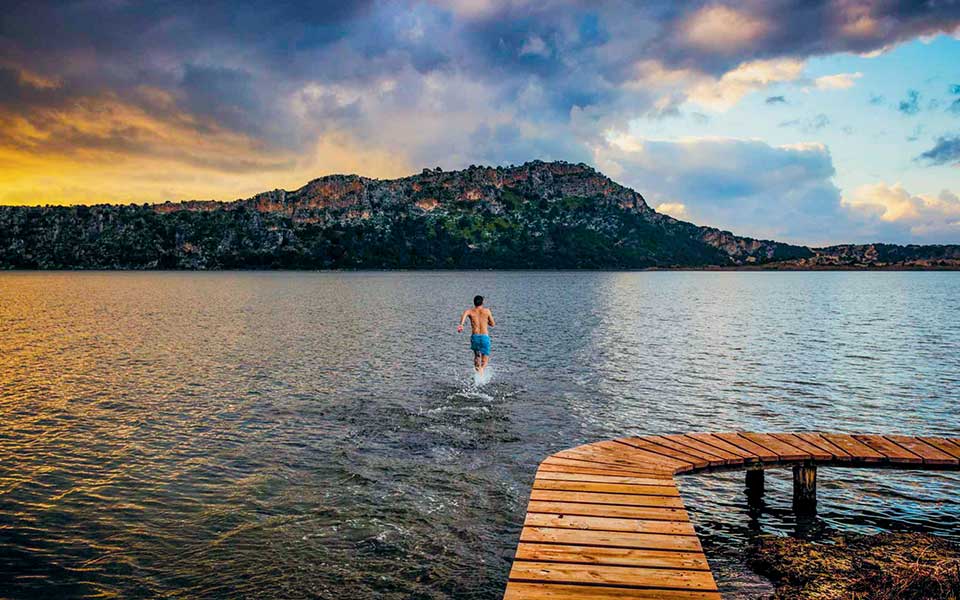
© Perikles Merakos
Messinia
Sea, history, local products, a wealth of activities: West Messinia is the absolute destination. The seaside areas of Gialova, Marathopoli and Kyparissia, as well as the mountain villages of Messinia are now on travelers’ itineraries, to whom they offer a variety of outdoor activities, delicious food, and high-quality accommodation.
What to See & Do
One of the most important wetlands in Europe, Gialova lagoon is a key stopping point for birds migrating to and from Africa; more than 250 bird species have been recorded in the area. It is also the only European habitat of the African chameleon. Visit the observation stations of the Ornithological Society, and follow the nature walk they have created which passes through the 8 different ecosystems of the lagoon.
One of the best preserved Mycenaean palaces lies 18km north of Pylos. Nestor’s Palace reached the peak of its powers between 1300 and 1200 BC and is located in a prime spot of Messinian land with a breathtaking view of Navarino Bay. The throne room with its large circular hearth, a well-preserved marble bath and the various pottery used to store products such as olive oil and essential oils, are truly impressive. A whole world awaits beneath the waves in the Bay of Navarino and surrounding areas, and the only way to explore it is by scuba diving. Shipwrecks from the Roman and Byzantine eras, as well as the 20th century, will be revealed, like the tanker Irene’s Serenade, sunk in 1980. There are many diving schools in the area, such as the Ionian Dive Center in Marathopoli.
Where to Swim
Aside from the famous Voidokilia Beach (aka Omega Beach), next to the lagoon of Gialova, the area offers many other options for swimming in the crystal-clear waters of the Ionian Sea. Between the lagoon and Navarino Bay, you will find most locals on Golden Beach, also known as Divari. The beach is 4km long, with fine sand and turquoise waters and a beach bar at one end.
A little bit to the north, 16km from Pylos, there is another beautiful sandy beach, that of Petrochori. 21km from Pylos, on the way to ancient Messene, lies Polylimnio, a beautiful network of waterfalls and lakes. The total distance from where you park your car until the last waterfall is almost 3km. If the weather allows take a dip in the bracing waters. For great swims, visit the coastal villages of Messinian Mani, particularly Kitries, the farthest village on the Bay of Messinia.

